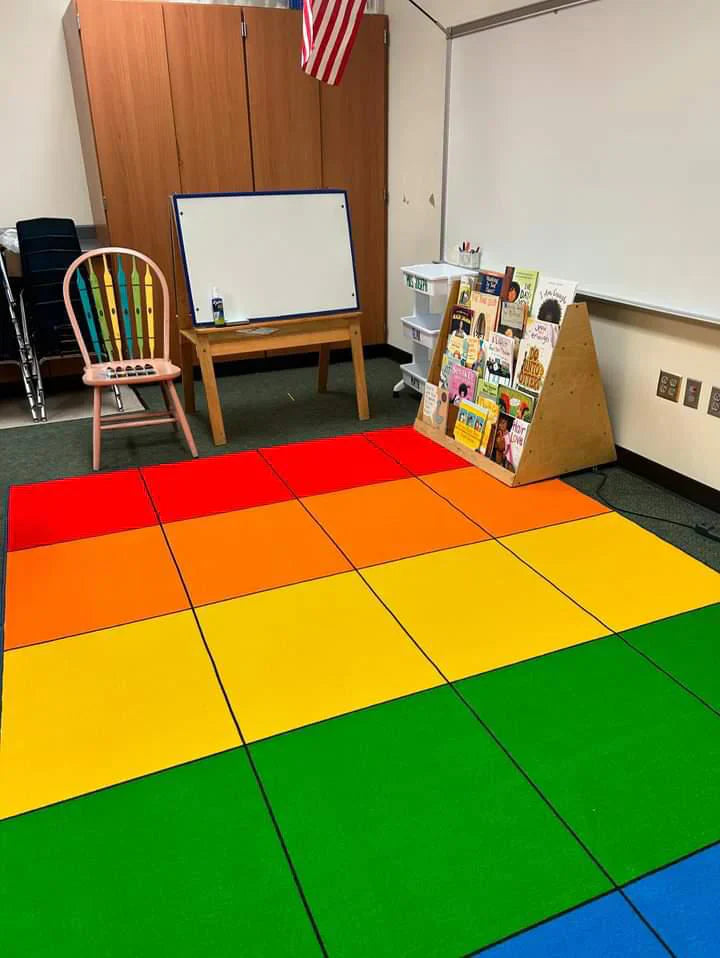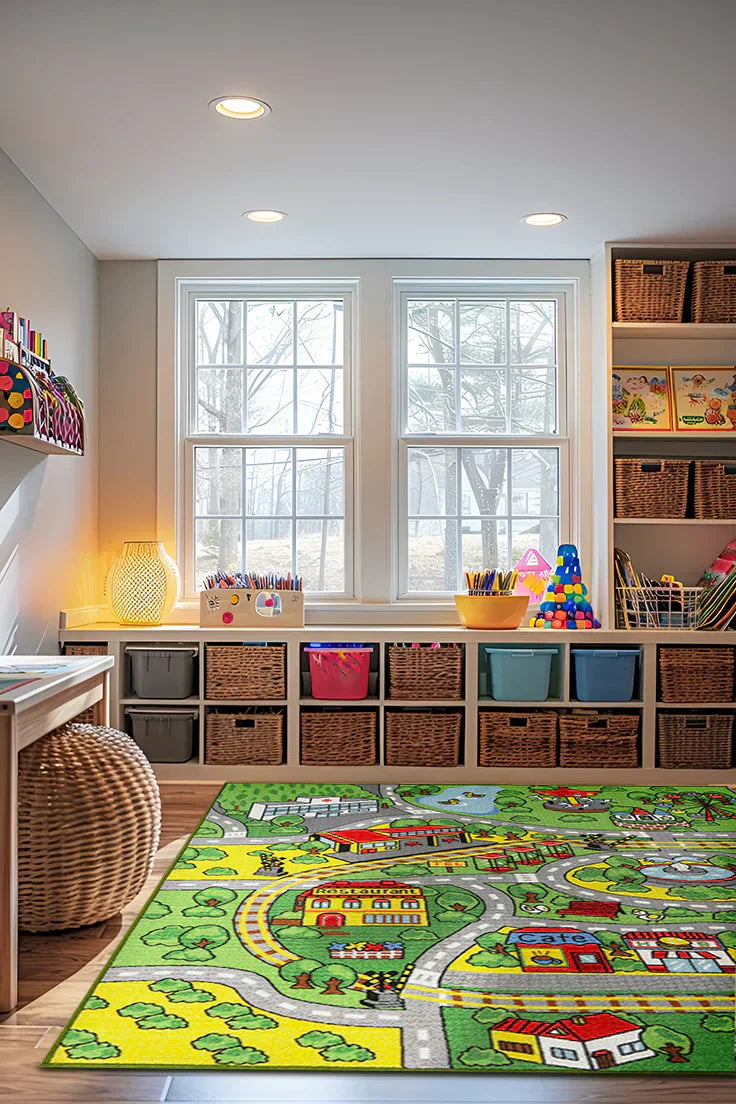Understanding Sensory Processing in Educational Settings
Sensory processing refers to how the central and peripheral nervous systems manage incoming information from different sensory modalities, including the internal modalities of proprioception and vestibular systems, as well as the traditional five senses.
Children with sensory processing differences may experience hypersensitivity (over-responsiveness) or hyposensitivity (under-responsiveness) to various stimuli.
Research demonstrates that classroom environments significantly impact student engagement and academic performance, particularly for children with autism spectrum disorder (ASD) and attention deficit hyperactivity disorder (ADHD).
Explore our full range of classroom rugs designed for sensory support
These students face unique challenges when accessing educational material in traditional classroom settings due to atypical sensory processing and attentional impairments.
The Science Behind Sensory-Friendly Design
Recent studies show that students with ASD and ADHD exhibit statistically significant differences in sensory processing patterns compared to neurotypical children.
Visual stimuli, including patterns, colors, and textures, can have profound impacts on their ability to learn and participate in classroom activities.
The key principle in sensory-friendly design is creating predictable, calming environments that reduce sensory overload while providing appropriate stimulation for those who need it.
This approach benefits not only children with diagnosed sensory processing differences but also supports the learning needs of all students in inclusive classrooms.
Learn how Booooom Jackson’s sensory-focused rugs are helping educators build more inclusive classrooms.
Booooom Jackson's Sensory-Conscious Design Philosophy
Evidence-Based Color Psychology
Our design team incorporates research-backed color psychology to create carpets that support sensory regulation.
Understanding that each child's sensory profile is unique, we focus on designs that provide calming foundations while offering opportunities for sensory input when needed.
Color Selection Principles:
- Earth tones and muted palettes that absorb chaos and provide visual rest
- High-contrast elements for children who need stronger visual input
- Predictable color patterns that reduce visual overwhelm
- Nature-inspired hues that promote calming responses
Texture and Pattern Considerations
Sensory-friendly patterns must balance visual interest with calming properties. Our carpets feature designs that provide:
- Organized visual structure that helps children with autism navigate their environment
- Predictable patterns that reduce anxiety and support visual processing
- Low-pile construction that prevents tripping and provides stable tactile input
- Non-slip backing that ensures safety during sensory-seeking movements
Featured Sensory-Supportive Products
Boho Style Grid Classroom Rug: Earth-Tone Tranquility
Our Boho Style Grid Classroom Rug exemplifies sensory-friendly design with its calm earth-tone palette that "absorbs chaos like a noise-canceling blanket for overstimulated afternoons."
The geometric zigzag patterns provide predictable visual structure while the desert-inspired colors create a naturally soothing environment.
Sensory Benefits:
- Calm Palette: Earth tones reduce visual overstimulation
- Geometric Structure: Predictable patterns support children who need visual organization
- Spacious Design: 157"L x 90"W accommodates 24 students with adequate personal space
- Low Sensory Input: Subtle patterns prevent visual overwhelm
Key Features for Special Needs:
- Phthalate-free dyes ensure safety for children with chemical sensitivities
- Non-slip backing supports children who seek proprioceptive input through movement
- Easy-clean surface reduces stress for families managing sensory-related behaviors
Nature-Themed Organic Designs: Biophilic Sensory Support
Our Nature-Themed Classroom Rugs leverage biophilic design principles, recognizing that connections with nature can reduce screen-time stress and provide calming sensory input.
These designs help children with sensory processing differences by offering:
Natural Sensory Regulation:
- Organic patterns that mirror the non-threatening complexity of nature
- Soft color gradients that avoid harsh visual contrasts
- OEKO-TEX® certified materials ensuring chemical-free environments for sensitive children
- Hypoallergenic properties supporting children with multiple sensitivities
Therapeutic Applications:
- Forest patterns provide visual "white noise" for overstimulated children
- Animal motifs offer engaging focal points for hypofocused learners
- Natural textures (woven patterns) provide appropriate tactile input
Circle Alphabet Classroom Rug: Structured Learning Support
The Circle Alphabet Classroom Rug combines educational content with sensory-friendly design principles.
The circular format provides natural boundaries that help children with autism understand their personal space while engaging in learning activities.
Autism-Specific Benefits:
- Clear visual boundaries reduce anxiety during group activities
- Predictable letter placement supports children who thrive on routine
- Soft, comfortable surface provides appropriate sensory input for floor-based learning
- 79" x 79" round design creates defined personal spaces within group settings
ADHD-Supportive Features:
- Bold, contrasting letters provide necessary visual stimulation
- Interactive design elements support children who need movement during learning
- Durable construction withstands fidgeting and active use
Educational Pencil Design Rug: Visual Organization Systems
Our Educational Pencil Design Classroom Rug features organized visual elements along the border that provide structure without overwhelming the central space.
This design supports children who need visual organization while maintaining a calm learning environment.
Sensory Processing Support:
- Border patterns create visual frames that help organize visual field
- Central calm space provides visual rest area
- Colorful elements strategically placed to engage without overstimulating
- Reading-focused design supports sustained attention and visual tracking
2025 Trends in Sensory-Friendly Classroom Design
Universal Design for Learning (UDL) Integration
Current educational trends emphasize creating learning environments that work for all students from the start, rather than retrofitting accommodations.
Sensory-friendly carpet patterns align with UDL principles by:
- Providing multiple means of engagement through varied visual and tactile inputs
- Supporting different learning styles with organized visual structures
- Reducing barriers to participation by minimizing sensory overload
Technology Integration with Sensory Design
As classrooms become more technology-rich, the need for sensory balance becomes even more critical. Our carpets serve as "analog anchors" in digital learning environments, providing:
- Visual rest areas that counterbalance screen brightness
- Tactile grounding for children overwhelmed by digital stimulation
- Predictable sensory input that complements unpredictable technological elements
Mental Health and Sensory Regulation
The increasing focus on student mental health recognizes the crucial role sensory environments play in emotional regulation.
Sensory-friendly carpets support mental wellness by:
- Reducing daily stress through calming visual environments
- Providing safe spaces for sensory regulation
- Supporting emotional co-regulation through predictable environmental cues
Implementation Strategies for Educators
The FRIEND Framework for Sensory Accommodation
Educational professionals can use the FRIEND framework when implementing sensory-friendly carpets:
F - Flexibility in carpet placement and usage R - Routine establishment around carpet areas I - Individual consideration of each child's sensory profile E - Environmental awareness of sensory input levels N - Noise management through carpet sound absorption D - Design consciousness in pattern and color selection
Creating Sensory Zones
Effective sensory-friendly classrooms use carpets to create distinct zones:
- Calm-Down Areas: Using earth-tone, low-pattern carpets for sensory regulation
- Active Learning Spaces: Incorporating structured patterns that support engagement
- Transition Zones: Employing visual cues that help children navigate space changes
- Focus Areas: Providing visual organization through predictable patterns
Assessment and Adaptation
Regular assessment ensures carpet choices continue meeting student needs:
- Sensory diary tracking to identify effective patterns
- Student feedback on carpet comfort and functionality
- Behavioral observation to assess environmental impact
- Collaborative planning with occupational therapists and special education teams
Research-Backed Benefits of Sensory-Friendly Environments
Cognitive Function Improvements
Studies demonstrate that sensory-friendly environments support:
- Enhanced attention and focus through reduced distracting stimuli
- Improved executive function via predictable environmental cues
- Better working memory when sensory processing demands are reduced
- Increased task engagement in appropriately designed spaces
Social-Emotional Development
Sensory-supportive environments promote:
- Reduced anxiety through predictable visual patterns
- Improved emotional regulation via calming color palettes
- Enhanced peer interaction when sensory barriers are removed
- Greater sense of belonging in inclusive learning spaces
Academic Achievement
Research indicates that children in sensory-friendly environments show:
- Higher on-task behavior during instructional activities
- Improved reading comprehension in visually organized spaces
- Better mathematical reasoning when visual overwhelm is reduced
- Increased participation in group learning activities
Safety and Quality Standards
Comprehensive Safety Testing
All Booooom Jackson sensory-friendly carpets meet rigorous safety standards essential for special needs populations:
- ASTM International and CPSC compliance ensuring physical safety
- OEKO-TEX® certification guaranteeing chemical safety for sensitive children
- Non-toxic, eco-friendly materials free from PVC, phthalates, and lead
- Hypoallergenic properties supporting children with multiple sensitivities
Durability for Special Needs Use
Children with sensory processing differences may use carpets more intensively, requiring:
- Reinforced edges that withstand repetitive behaviors
- Stain-resistant surfaces for easy maintenance
- Fade-resistant colors maintaining visual consistency over time
- 80% increased slip resistance supporting safe movement exploration
Supporting Families and Educators
Professional Development Resources
Booooom Jackson supports implementation through:
- Educational materials about sensory processing in learning environments
- Professional consultation for optimal carpet selection
- Training resources for recognizing sensory needs in classrooms
- Collaborative planning tools for inclusive environment design
Home-School Coordination
Effective sensory support requires consistency across environments:
- Pattern matching between home and school carpets
- Sensory profile sharing between families and educators
- Transition support using familiar visual elements
- Collaborative goal setting for sensory regulation development
Addressing Common Challenges
Individual Sensory Differences
While some children need calming environments, others require more stimulation. Our approach addresses this through:
- Flexible carpet placement allowing for individual positioning
- Pattern variation within single designs to meet diverse needs
- Customization options for specific sensory profiles
- Transitional design elements supporting different sensory preferences
Budget and Practical Considerations
Implementing sensory-friendly environments requires practical solutions:
- Bulk pricing for schools and organizations
- Long-term durability reducing replacement costs
- Multi-purpose designs maximizing educational and sensory value
- Easy maintenance reducing ongoing care burden
Professional Collaboration
Successful implementation involves multiple professionals:
- Occupational therapists for sensory assessment and recommendations
- Special education specialists for learning accommodation strategies
- Classroom teachers for daily implementation and observation
- Administrators for policy support and resource allocation
Future Directions in Sensory-Friendly Design
Emerging Research Applications
Current research is exploring:
- Personalized sensory environments based on individual processing profiles
- Technology integration that complements sensory-friendly physical spaces
- Cross-cultural sensory preferences in increasingly diverse classrooms
- Long-term developmental outcomes of sensory-supportive educational environments
Innovation in Materials and Design
Future developments may include:
- Smart textiles that respond to environmental conditions
- Modular carpet systems allowing for easy reconfiguration
- Biodegradable materials supporting environmental and health goals
- Integration with assistive technologies for enhanced accessibility
Building Inclusive Learning Communities
Whole-School Approaches
Successful sensory-friendly environments require comprehensive planning:
- Consistent design principles throughout educational facilities
- Professional development for all staff members
- Family engagement in sensory environment planning
- Student voice in design and implementation decisions
Community Partnerships
Effective programs involve:
- Healthcare provider collaboration for comprehensive support
- Community organization partnerships for resource sharing
- Research institution connections for evidence-based practices
- Industry partnerships for innovative solution development
Conclusion: Creating Foundations for Success
Sensory-friendly carpet patterns represent more than aesthetic choices—they are evidence-based interventions that support the learning and development of children with special needs while benefiting all students in inclusive classrooms.
As our understanding of sensory processing differences continues to evolve, thoughtful environmental design becomes increasingly critical for educational success.
Booooom Jackson's commitment to sensory-conscious design reflects our understanding that every child deserves learning environments that support their unique sensory needs.
Through careful attention to color psychology, pattern organization, material safety, and evidence-based design principles, our carpets create foundations for academic, social, and emotional success.
By investing in sensory-friendly learning environments today, we build inclusive communities where all children can thrive.
The ripple effects of these supportive spaces extend beyond individual student outcomes to create more empathetic, understanding, and inclusive educational cultures for generations to come.
Related Resources:
- Sensory Processing Disorder Information - Wikipedia
- Autism Spectrum Disorder Educational Support - Wikipedia
- ADHD and Sensory Processing - Wikipedia
- Universal Design for Learning - Wikipedia
- Inclusive Education Practices - Wikipedia




Leave a comment
This site is protected by hCaptcha and the hCaptcha Privacy Policy and Terms of Service apply.